| Listing 1 - 8 of 8 |
Sort by
|
Book
ISBN: 1634853849 9781634853842 9781634853651 1634853652 Year: 2016 Publisher: New York
Abstract | Keywords | Export | Availability | Bookmark
 Loading...
Loading...Choose an application
- Reference Manager
- EndNote
- RefWorks (Direct export to RefWorks)
Crayfish --- Crawdaddies --- Crawdads --- Crawfish --- Crawfishes --- Crayfishes --- Decapoda (Crustacea) --- Astacology
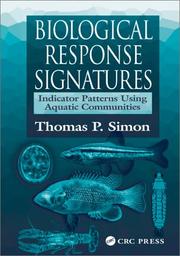
ISBN: 0849309050 9780849309052 Year: 2003 Publisher: Boca Raton (Fla.): CRC,
Abstract | Keywords | Export | Availability | Bookmark
 Loading...
Loading...Choose an application
- Reference Manager
- EndNote
- RefWorks (Direct export to RefWorks)
This is the first book that evaluates the application of multimetric indices and biological indicators as endpoints in order to determine the relevancy of monitoring and evaluating programs in North America so that patterns in biological responses can be assessed. It includes state-of-the-art diagnostic tools and examines patterns relating to point or non-point source impacts. From the conceptual framework to the case studies, this book will help readers better diagnose the stressors to biological communities and, thus, take actions to protect and restore water resources.
Aquatic ecology. --- Basic Sciences. Biotechnology --- Environmental Sciences and Forestry. Ecology --- Environmental Sciences and Forestry. Water Management --- Indicators (Biology). --- Water quality biological assessment. --- Biosafety, Risk Evaluation. --- Aquatic Ecology. --- Water Quality. --- Indicators (Biology) --- Water quality biological assessment --- Aquatic ecology
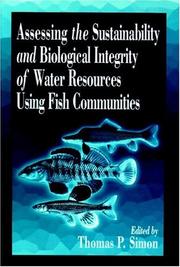
ISBN: 0849340071 Year: 1999 Publisher: Boca Raton (Fla.) : CRC Press,
Abstract | Keywords | Export | Availability | Bookmark
 Loading...
Loading...Choose an application
- Reference Manager
- EndNote
- RefWorks (Direct export to RefWorks)
Dissertation
Year: 1882 Publisher: Leiden : S.C. van Doesburgh,
Abstract | Keywords | Export | Availability | Bookmark
 Loading...
Loading...Choose an application
- Reference Manager
- EndNote
- RefWorks (Direct export to RefWorks)
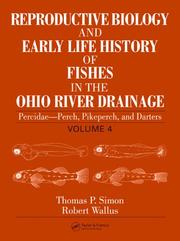
ISBN: 9780849319204 084931920X Year: 2005 Publisher: Boca Raton: CRC,
Abstract | Keywords | Export | Availability | Bookmark
 Loading...
Loading...Choose an application
- Reference Manager
- EndNote
- RefWorks (Direct export to RefWorks)
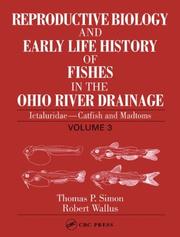
ISBN: 9780849319198 0849319196 Year: 2004 Publisher: Boca Raton: CRC,
Abstract | Keywords | Export | Availability | Bookmark
 Loading...
Loading...Choose an application
- Reference Manager
- EndNote
- RefWorks (Direct export to RefWorks)
Book
ISBN: 9400741286 9786613704733 9400741294 1280794348 Year: 2012 Publisher: Dordrecht ; New York : Springer,
Abstract | Keywords | Export | Availability | Bookmark
 Loading...
Loading...Choose an application
- Reference Manager
- EndNote
- RefWorks (Direct export to RefWorks)
Nutrient Indicator Models for Determining Biologically Relevant Levels: A case study based on the Corn Belt and Northern Great Plain Nutrient Ecoregion is the first book to provide answers to the management of nutrients based on changes in biological communities. The text describes a case study that is the result of a large scale project in the Corn Belt and Great Plains Nutrient Ecoregion. This study is the first to identify relationships between fish assemblages and nutrient concentrations by Nitrogen species. Species optima based on sensitvity and tolerance to nutrients is modeled. Nutrient Biotic indices calibrated for application are based on the results of years of biological indicator development. Test response intervals and Shift response intervals are formulated and validated against relevant biological assemblage shifts. This case study is the first to suggest recommended values for the nitrogen and phosphorus cycle with identifiable shifts caused in biological assemblages. This will provide watershed and environmental managers with the information needed to manage the inputs into the world’s dead zones.
Agriculture. --- Environmental sciences. --- Nutrient pollution of water -- Indiana. --- Public Health --- Civil & Environmental Engineering --- Health & Biological Sciences --- Engineering & Applied Sciences --- Environmental Health --- Environmental Engineering --- Nutrient pollution of water --- Water --- Pollution --- Lakes --- Nutrient pollution of rivers, lakes, etc. --- Rivers --- Nutrient pollution --- Environment. --- Applied ecology. --- Environmental management. --- Environmental health. --- Ecotoxicology. --- Environmental Health. --- Applied Ecology. --- Environmental Management. --- Hydrology --- Environmental Medicine. --- Environmental toxicology. --- Farming --- Husbandry --- Industrial arts --- Life sciences --- Food supply --- Land use, Rural --- Environmental stewardship --- Stewardship, Environmental --- Environmental sciences --- Management --- Ecotoxicology --- Pollutants --- Environmental health --- Toxicology --- Ecology --- Environmental protection --- Nature conservation --- Environmental quality --- Health --- Health ecology --- Public health --- Environmental engineering --- Health risk assessment --- Health aspects --- Environmental aspects
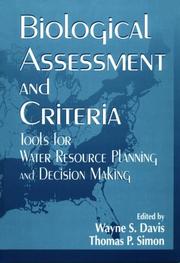
ISBN: 0873718941 Year: 1994 Publisher: Boca Raton ; London ; Tokyo Lewis
Abstract | Keywords | Export | Availability | Bookmark
 Loading...
Loading...Choose an application
- Reference Manager
- EndNote
- RefWorks (Direct export to RefWorks)
| Listing 1 - 8 of 8 |
Sort by
|

 Search
Search Feedback
Feedback About UniCat
About UniCat  Help
Help News
News